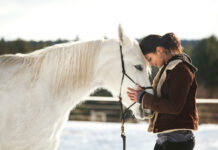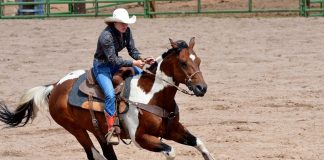
Q: My horse spooks every time he sees a rope when we’re trying to catch cattle. Do you have any pointers?
You can desensitize your horse to objects moving above his eye level using the “Helicopter Exercise.” Although I recommend initially teaching it using a stick and string, you can later practice the following steps using a lariat.
1. Position yourself. Stand at a 45-degree angle to your horse’s left shoulder, an arm’s length away. This is the safest place to stand whenever you introduce something new because you’ll be too far in front to get kicked by a hind leg and too far to the side to get struck by a front leg.
Hold the lead rope about a foot and a half from the snap with your left hand and lift it so that it’s level with your horse’s eye. Stand with your belly button facing your horse’s hindquarters. This will enable you to bring his head toward you if he chooses to run around you in a circle or turn away from you. If he pushes into you, you’ll be able to drive him away by tapping his jaw or neck with your hand.
2. Position the stick. Hold the stick in your right hand as though you’re shaking someone’s hand. Pretend that you’re standing in the middle of a clock. In front of your belly button is 12 o’clock, and behind you is 6 o’clock. Hold your right arm out straight so that the end of the stick rests on the ground at roughly 5 o’clock.
3. Swing the stick. Keeping your arm relatively straight, swing the stick and string up and over your horse’s hindquarters, back and neck and then back down to the 5 o’clock position you started in. Aim for a smooth motion. Always come back down to the 5 o’clock position so that you don’t accidentally whack your horse in the head. If your arm gets tired and starts to sag, you could hit his ears.
As you get better, take the pause out so that your arm never stops moving. Still bring the stick back down to the 5 o’clock position when you’re done. If your horse tries to move away, continue swinging the stick and string, bringing his head toward you or pushing it away with your hand on the lead rope as mentioned in step 1.
4. When your horse stands still and relaxes, retreat and rub him with the stick and string.
5. Speed it up. Swing the stick faster so it makes more noise.
6. Change sides. When your horse is consistently standing still and relaxed, change sides and repeat steps 1 through 5.
7. When your horse is comfortable with the helicopter on both sides, walk 360 degrees around him while swinging the stick. To do this, double the tail of the lead rope and throw it over your horse’s back. Starting on his left, place your left hand flat on his side. Hold the stick in your right hand and swing it in the helicopter motion.
As you swing the stick up and over your horse’s body in a continuous motion, slowly start to walk around him. Be sure to keep your left hand on your horse the entire time.
When you reach your starting point again, turn around, switch hand positions, and walk 360 degrees around your horse the other way.
If at any point your horse moves his feet, raises his head or looks worried, keep your feet still and continue swinging the stick in that exact spot until he relaxes. If he moves away, make sure you follow him while continuing to swing the stick up and over his body.
8. Speed it up. Swing the stick faster so it makes more noise as you walk around your horse.
Clinician CLINTON ANDERSON owns and operates Downunder Horsemanship in Stephenville, Texas, where his method of horsemanship has helped to transform the relationships between thousands of horses and riders. He also hosts two training programs that air weekly on Fox Sports Net and RFD-TV.
www.downunderhorsemanship.com.
This article originally appeared in the November 2013 issue of Horse Illustrated. Click here to subscribe.





